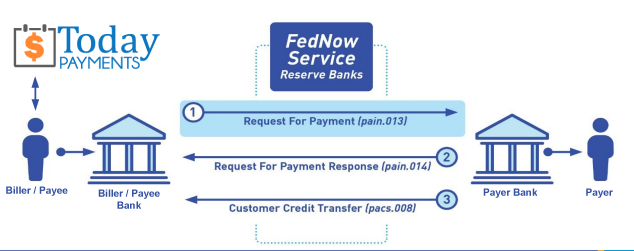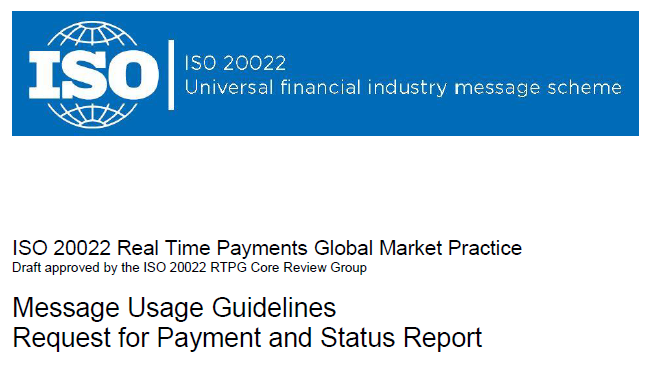Create Request for Payment File
Create Request for Payment File – Real-Time RfPs with ISO 20022, XML, XLS, and CSV
Create Request for Payment File workflows allow merchants and platforms to initiate real-time transactions using structured formats compatible with FedNow® and RTP® rails. Whether one-time or recurring, static or variable, RfPs can be built using formats like ISO 20022 XML, .XLS, or .CSV, then submitted through financial dashboards to complete instant, irrevocable credit transactions.
Build Real-Time Payment Requests with Accuracy and Flexibility
Modern digital payment systems require agility in file format, reliability in data structure, and speed in settlement. With FedNow® and RTP®, Request for Payment (RfP) files deliver good funds in real time when properly constructed and submitted.
Using alias-based identifiers (mobile numbers, emails, SMS), merchants can design a real-time payment file using ISO 20022 rich data, XML scripts, or user-friendly Excel spreadsheets. These files drive automation for both credit-based and debit-style recurring billing workflows.
While every Real-Time Payment is a credit, recurring requests behave like a debit: the payer authorizes a repeatable payment without needing to swipe or sign, all through secure RfP interactions.
Key Benefits and Features When Creating RfP Files:
- Supports one-time and recurring (static or variable) transactions
- Accepted formats: ISO 20022 XML, .xls, .csv, .html
- Alias-based payment routing (mobile, email, SMS)
- Structured data formats enable rich metadata per transaction
- FedNow® and RTP® compatible with all U.S. banks
- Fully mapped “credit” that operates as recurring “debit” for subscriptions
- Import, upload, and download tools built into payee dashboards
- No chargebacks, full traceability, and instant fund availability
- Free reconciliation reports via Excel for aging and auditing
- Ideal for billing, invoicing, membership, and B2B payments
Modes of Creating a Request for Payment File
There are multiple ways to generate an RfP file based on your technical preferences and business workflows:
- ISO 20022 XML: Ideal for enterprise-level automation, using pain.001 or pain.013 message types for structured payment data.
- Excel (.XLS): Upload spreadsheets with pre-formatted columns like payer alias, amount, due date, and description.
- CSV (.CSV): Perfect for batch uploads and integrations from accounting software or ERPs.
- HTML Forms: For web-based RfP generation with Hosted Payment Page links tied to each alias.
- API or Scripted JSON (optional): For advanced users automating via backend systems and fintech platforms.
Each RfP file includes transaction metadata, payee/payer aliases, invoice numbers, and remittance details. Once uploaded, the file is validated and routed through RTP® or FedNow® to the recipient’s financial institution.
Importing and Uploading RfP Files through Payee Dashboards
Once created, your RfP file can be imported, uploaded, or downloaded using a connected payee dashboard linked to all U.S. financial institutions.
Dashboards allow merchants to:
- Upload single or batch RfP files using any supported format
- Monitor RfP status (pending, approved, rejected, expired) in real time
- Reattempt failed requests using return/reject codes
- Send email/SMS reminders for outstanding RfPs
- Track recurring payments and automate next billing cycle
- Download AR aging reports for reconciliation
- Access free bank reconciliation tools linked to your FedNow® settlements
Creating a FedNow Instant and Real-Time Payments (RTP) Request for Payment (RfP) file involves generating a properly formatted ISO 20022 XML file. This standard is used by both FedNow and RTP to structure payment request messages between financial institutions. Below is a step-by-step guide to help you create an RfP file that complies with FedNow and RTP requirements.
Step 1: Understand the Components of an RfP File
An RfP (Request for Payment) file includes the following key components:
- Payee Information: Details about the person or entity requesting payment.
- Payer Information: Details about the person or entity responsible for paying.
- Payment Information: Includes the amount, currency, due date, and invoice reference.
- Message Details: Metadata about the request.
Step 2: ISO 20022 XML Structure for RfP File
Below is the basic structure for an ISO 20022 XML Request for Payment (RfP) file. This example includes a request for payment where a business (ABC Corp) is requesting a payment from a customer (John Doe).
Example of an RfP in ISO 20022 XML Format:
xml
<?xml version="1.0" encoding="UTF-8"?>
<Document xmlns="urn:iso:std:iso:20022:tech:xsd:pain.013.001.07">
<ReqForPaymt>
<!-- Payee Information -->
<PayeeInfo>
<Name>ABC Corp</Name>
<AcctNumber>123456789</AcctNumber>
<RoutingNumber>987654321</RoutingNumber>
</PayeeInfo>
<!-- Payer Information -->
<PayerInfo>
<Name>John Doe</Name>
<AcctNumber>987654321</AcctNumber>
<RoutingNumber>123456789</RoutingNumber>
</PayerInfo>
<!-- Payment Information -->
<PaymentInfo>
<Amount>500.00</Amount>
<Currency>USD</Currency>
<DueDate>2024-10-01</DueDate>
<InvoiceRef>INV-1001</InvoiceRef>
</PaymentInfo>
<!-- Additional Metadata -->
<MessageInfo>
<MessageId>RFP-INV-1001</MessageId>
<CreationDate>2024-09-10T10:15:30</CreationDate>
</MessageInfo>
</ReqForPaymt>
</Document>
Key Elements Explained:
- PayeeInfo: Contains the details of
the person or entity requesting the payment.
- Name: The name of the payee (e.g., ABC Corp).
- AcctNumber: The payee's bank account number.
- RoutingNumber: The payee's routing number (ABA).
- PayerInfo: Contains the details of
the person or entity expected to make the payment.
- Name: The name of the payer (e.g., John Doe).
- AcctNumber: The payer's bank account number.
- RoutingNumber: The payer's routing number (ABA).
- PaymentInfo: Contains the payment
details.
- Amount: The amount of money requested (e.g., 500.00).
- Currency: The currency in which the payment is requested (e.g., USD).
- DueDate: The date by which the payment should be made (e.g., 2024-10-01).
- InvoiceRef: The invoice or reference number (e.g., INV-1001).
- MessageInfo: Contains additional
metadata.
- MessageId: A unique identifier for this specific request for payment.
- CreationDate: The timestamp when the message was created.
Step 3: Create Multiple RfP Entries for Batch Uploads (Optional)
If you need to submit multiple RfP requests at once (for a batch process), you can add multiple <ReqForPaymt> entries within the <Document> tag.
Example of Batch RfP XML File:
xml
<?xml version="1.0" encoding="UTF-8"?>
<Document xmlns="urn:iso:std:iso:20022:tech:xsd:pain.013.001.07">
<ReqForPaymt>
<PayeeInfo>
<Name>ABC Corp</Name>
<AcctNumber>123456789</AcctNumber>
<RoutingNumber>987654321</RoutingNumber>
</PayeeInfo>
<PayerInfo>
<Name>John Doe</Name>
<AcctNumber>987654321</AcctNumber>
<RoutingNumber>123456789</RoutingNumber>
</PayerInfo>
<PaymentInfo>
<Amount>500.00</Amount>
<Currency>USD</Currency>
<DueDate>2024-10-01</DueDate>
<InvoiceRef>INV-1001</InvoiceRef>
</PaymentInfo>
<MessageInfo>
<MessageId>RFP-INV-1001</MessageId>
<CreationDate>2024-09-10T10:15:30</CreationDate>
</MessageInfo>
</ReqForPaymt>
<ReqForPaymt>
<PayeeInfo>
<Name>XYZ LLC</Name>
<AcctNumber>2233445566</AcctNumber>
<RoutingNumber>654321987</RoutingNumber>
</PayeeInfo>
<PayerInfo>
<Name>Jane Smith</Name>
<AcctNumber>1122334455</AcctNumber>
<RoutingNumber>321654987</RoutingNumber>
</PayerInfo>
<PaymentInfo>
<Amount>300.00</Amount>
<Currency>USD</Currency>
<DueDate>2024-09-25</DueDate>
<InvoiceRef>INV-1002</InvoiceRef>
</PaymentInfo>
<MessageInfo>
<MessageId>RFP-INV-1002</MessageId>
<CreationDate>2024-09-11T12:30:00</CreationDate>
</MessageInfo>
</ReqForPaymt>
</Document>
Step 4: Validate the RfP File
Before submitting your RfP file, it’s essential to validate it to ensure that the XML structure complies with the ISO 20022 schema and your bank's specific requirements. You can use online XML validation tools or tools provided by your bank to validate the file.
- XML Validators: Use online XML validators to check for errors or missing fields.
- Bank-Specific Tools: Some banks provide validation tools to check the XML file format before submission.
Step 5: Submit the RfP File to Your Bank
After preparing and validating the RfP file, you need to upload it to your business bank’s dashboard for FedNow or RTP real-time processing.
a) Log in to Your Bank’s Dashboard:
- Use your credentials to log in to your bank’s online platform.
b) Navigate to the RfP Section:
- Look for the Request for Payment (RfP) section under FedNow or Real-Time Payments (RTP) services.
c) Upload the RfP File:
- Select the Batch Upload or File Import option.
- Choose the XML file you created.
- Review the data and submit the file for processing.
d) Monitor the Status:
- Once uploaded, you can monitor the status of each RfP (pending, completed, or rejected) in the dashboard. Ensure that the payments are processed in real-time.
Step 6: Reconcile Payments
After payments have been processed:
- FedNow and RTP will provide real-time notifications and settlement details.
- Use this information to reconcile payments in your internal accounting systems or tools like QuickBooks.
Key Considerations:
- Compliance: Ensure all fields are filled correctly to meet regulatory and compliance requirements.
- File Format: The RfP file must follow the ISO 20022 format required by FedNow and RTP.
- Security: Always ensure the secure transmission of your files when uploading them to your bank’s portal.
Conclusion
By following this guide, you can create an ISO 20022 XML-based Request for Payment (RfP) file for FedNow and Real-Time Payments (RTP). Once prepared, the file can be uploaded to your business bank’s dashboard for real-time payment processing. This process ensures that your payments are handled efficiently and in compliance with current payment standards.
Build and Upload Real-Time RfPs Today at TodayPayments.com
Don’t let outdated payment files hold you back.
✅ Create RfPs in ISO 20022, XML,
Excel, or CSV
✅ Accept alias-based payments via FedNow®
or RTP®
✅ Eliminate ACH delays, paper
invoicing, and chargebacks
✅ Get paid faster with full
reconciliation and dashboard control
✅ Support
one-time and recurring “debit-style” billing
with real-time certainty
Create, upload, and process RfPs with
confidence at
https://www.TodayPayments.com
Real-Time Payments Done
Right – Structured, Secure, and Instant.
Creation Request for Payment Bank File
Call us, the .csv and or .xml FedNow or Request for Payment (RfP) file you need while on your 1st phone call! We guarantee our reports work to your Bank and Credit Union. We were years ahead of competitors recognizing the benefits of RequestForPayment.com. We are not a Bank. Our function as a role as an "Accounting System" in Open Banking with Real-Time Payments to work with Billers to create the Request for Payment to upload the Biller's Bank online platform. U.S. Companies need help to learn the RfP message delivering their bank. Today Payments' ISO 20022 Payment Initiation (PAIN .013) shows how to implement Create Real-Time Payments Request for Payment File up front delivering a message from the Creditor (Payee) to it's bank. Most banks (FIs) will deliver the message Import and Batch files for their company depositors for both FedNow and Real-Time Payments (RtP). Once uploaded correctly, the Creditor's (Payee's) bank continues through a "Payment Hub", will be the RtP Hub will be The Clearing House, with messaging to the Debtor's (Payer's) bank.

... easily create Real-Time Payments RfP files. No risk. Test with your bank and delete "test" files before APPROVAL on your Bank's Online Payments Platform.
Today Payments is a leader in the evolution of immediate payments. We were years ahead of competitors recognizing the benefits of Same-Day ACH
and Real-Time Payments funding. Our business clients receive faster
availability of funds on deposited items and instant notification of
items presented for deposit all based on real-time activity.
Dedicated to providing superior customer service and
industry-leading technology.


1) Free ISO 20022 Request for Payment File Formats, for FedNow and Real-Time Payments (The Clearing House) .pdf for you manually create "Mandatory" (Mandatory data for completed file) fields, start at page 4, with "yellow" highlighting. $0.0 + No Support
2) We create .csv or .xml formatting using your Bank or Credit Union. If Merchants has created an existing A/R file, we CLEAN, FORMAT to FEDNOW or Real-Time Payments into CSV or XML. Create Multiple Templates. You can upload or "key data" into our software for File Creation of "Mandatory" general file.
Fees = $57 monthly, including Activation, Support Fees and Batch Fee, Monthly Fee, User Fee, Additional Payment Method on "Hosted Payment Page" (Request for file with an HTML link per transaction to "Hosted Payment Page" with ancillary payment methods of FedNow, RTP, ACH, Cards and many more!) + $.03 per Transaction + 1% percentage on gross dollar file,
3) Payer Routing Transit and Deposit Account Number is NOT required to import with your bank. We add your URI for each separate Payer transaction.
Fees Above 2) plus $29 monthly additional QuickBooks Online "QBO" formatting, and "Hosted Payment Page" and WYSIWYG
4) Above 3) plus Create "Total" (over 600 Mandatory, Conditional & Optional fields of all ISO 20022 Pain .013) Price on quote.
Each day, thousands of businesses around the country are turning their transactions into profit with real-time payment solutions like ours.
Activation Dynamic RfP Aging and Bank Reconciliation worksheets - only $49 annually
1. Worksheet Automatically Aging for Requests for Payments and Explanations
- Worksheet to determine "Reasons and Rejects Coding" readying for re-sent Payers.
- Use our solution yourself. Stop paying accountant's over $50 an hour. So EASY to USE.
- No "Color Cells to Match Transactions" (You're currently doing this. You won't coloring with our solution).
- One-Sheet for Aging Request for Payments
(Merge, Match and Clear over 100,000 transactions in less than 5 minutes!)
- Batch deposits displaying Bank Statements are not used anymore. Real-time Payments are displayed "by transaction".
- Make sure your Bank displaying "Daily FedNow and Real-time Payments" reporting for "Funds Sent and Received". (These banks have Great Reporting.)
Contact Us for Request For Payment payment processing

